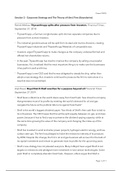Cases CSOG
Session 2 - Corporate Strategy and The Theory of (the) Firm (Boundaries)
Patrick McGee, ThyssenKrupp splits after pressure from investors, Financial Times,
September 27, 2018
- ThyssenKrupp, a German conglomerate, split into two separate companies due to
pressure from activist investors.
- The industrial goods business will be split from its steel and marine divisions, creating
ThyssenKrupp Industrials and ThyssenKrupp Materials of comparable size.
- Investors urged ThyssenKrupp to make changes as the company underperformed and
offered low shareholder returns.
- In the past, ThyssenKrupp has tried to improve the company by selling unsuccessful
businesses. Yet, it realised that the most important thing is to make sure the businesses
it has perform well and thrive.
- ThyssenKrupp's new CEO said that he was obligated to steady the ship, rather than
adopt a new strategy. But, investors continued to pressure the firm to restructure in a
way that was not centralised.
Anjli Raval, Royal Dutch Shell searches for a purpose beyond oil Financial Times
September 27 2019.
- Shell faces a dilemma as the world steers away from fossil fuels: how should a company
that generates most of its profits by meeting the world's demand for oil and gas
navigate the future as the political tide turns against fossil fuels?
- Shell is the world's biggest dividend payer. Two-thirds of Shell's free cash flow is tied to
its oil business. The CEO hopes that this will be split equally between oil, gas, and clean
power, because it has to find a way to preserve the dividend-paying capacity, while at
the same time growing the value of the company and changing the make-up of the
company.
- Shell has invested in wind and solar-power projects, hydrogen electric energy, and low-
carbon start-ups. The firm has pledged to halve the emissions intensity of its products
by 2050. Despite this change, the firm's oil and gas business will account for the bulk of
its capital investment and remain to generate most its profits for the upcoming years.
- Shell's new strategy has not pleased everyone. Many lobbyist have urged Shell to set
targets on emissions and pledged more investment in low-carbon technologies. Some
push Shell to completely abandon fossil fuels. However, others argue that Shell is
Page 1 of 17
, Cases CSOG
making better decisions than its peers (e.g. BP). Some say abandoning oil and gas
prematurely would be something that Shell could not live with.
- Profits from Shell’s hydrocarbon businesses are required to invest in lower-carbon
energies. Until Shell can generate returns from cleaner businesses that match those of
oil and gas operations, ploughing money in without restraint is also not an option.
- It can be hard for Shell to win the trust of all of its' stakeholders.
Session 3 - Ownership of the Firm
Goldman Sachs IPO; Harvard Business School Case Study 9-800-016 1999 (revised
version 2006)
- In 1998, Goldman Sachs partners introduced an idea to sell a portion of their firm to the
investing public. This IPO idea had been proposed (and rejected) six times before.
- With record profits, the firm was doing fine in 1998, leading many partners to argue that
the firm should remain a private partnership. However, concerns about the size and
capabilities of the financial businesses created by recent mergers among Goldman's
rivals triggered the move to publicly traded shares to expand and achieve global
prestige with acquisitions.
- From Commercial Paper to Investment Banking: After many successful years since its
launch in 1869 as a commercial paper businesses, Goldman joined the New York Stock
Exchange in 1896. The relationships that grew from the commercial paper business
provided the foundation for a new line of business, underwriting, which later
transformed Goldman Sachs into an investment bank.
- John Whitehead, co-head of Goldman Sachs in the 1970s, wrote the Fourteen
Commandments that guided the firm's development efforts in terms of corporate ethic.
- Unlike other department, Goldman's M&A department experienced rapid growth from
1976 to 1989. It was Goldman's policy not to represent hostile bids, because of the
mistrust among CEOs towards investment bankers. As a result, Goldman was perceived
as a trustworthy partner and had many successful M&As.
- Goldman promoted talent from within its own ranks, because hires not raised in the firm
might have posed a threat to its' cultural foundation.
- Partners were chosen once every two years. A partner could recommend to the
management committee for partnership any executive who had bene recruited directly
Page 2 of 17
, Cases CSOG
by Goldman and had worked for 8 to 10 years. Experience in the business was key, not
only work within the firm.
- Goldman's professionals were renowned for working long hours (14-18 hours a day) at
salaries often lower than they could earn at rival publicly held firms. They viewed this as
investments that might one day translate to partnership.
- In 1986, the first IPO idea arose for more capital in order to successfully compete in a
new, globalised environment. Yet, skeptics believed that an IPO would hurt Goldman's
partnership arrangement, which was the foundation of the corporate culture and
responsible for the firm's success. After debate, the first IPO proposal was declined.
- In 1990, Goldman's management divided each partnership class into thirds based on
an annual assessment of the partners' contributions to the fir. Partnership shares were
adjusted every two years when current partners renewed their partnership agreements,
along with newly elected partners. Management experienced struggles in redistributing
ownership to ensure vitality.
- In 1994, Goldman had a disastrous year with substantial financial losses driven by the
firm's extravagance and high-risk trading activity that coupled a short-term mentality
with poor risk management. The firm acknowledged that they cannot run a MNC on
partnership capital - that is, a risky business on top of a risky capital structure. As a
result, the firm changed its' capital structure:
Page 3 of 17






